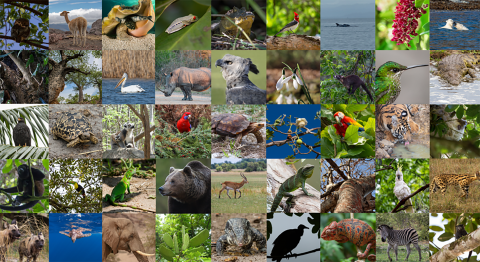What makes it possible for someone in the U.S. to purchase jewel orchids from Malaysia, or to sell American alligator boots in Europe, while ensuring these species persist in their native habitats? The answer is five decades of unprecedented international cooperation on wildlife trade.
In March 1973, nearly ten months before the U.S. Endangered Species Act was signed into law, representatives from 80 countries gathered in Washington, D.C., to finalize another milestone in conservation: the Convention on International Trade in Endangered Species of Wild Fauna and Flora.
Known as CITES, the Convention is an international treaty created to ensure the global trade in wildlife — including animals and plants — doesn’t threaten their survival in the wild.
Today, 183 countries and the European Union are Parties to CITES, meaning they agree to uphold its provisions in support of balancing legal, sustainable use with conservation of wild animals and plants.
Participation is mutually beneficial: sustainable, legal use of wild animals and plants is better for both domestic and global economies than unchecked illegal trade, which can drive species and associated markets to extinction.
Elephant in the room
Like the Endangered Species Act, CITES was a response to mounting concerns in the 1960s about alarming declines in the populations of iconic species of wildlife. The poster species for the Endangered Species Act was the bald eagle, whose numbers were plummeting due to habitat loss, shootings, and poisoning from DDT.
For CITES, it was the Asian elephant, which had been hunted to the brink of extinction to meet demand for ivory. When the treaty went into effect in 1975, the Asian elephant was among the first species listed. The African elephant was listed the following year.
Thanks to CITES, there is now a system in place to help elephant range countries around the world better manage their elephant populations and enforce the laws created to protect them.
Making a list
Listing has a different meaning under CITES than it does under the Endangered Species Act, which designates species as either “threatened” or “endangered” and, with limited exceptions, outlaws “take” — defined as harassing, harming, pursuing, hunting, shooting, wounding, killing, trapping, capturing, or collecting.
In contrast, CITES regulates, rather than bans, international trade in species that the Parties agree to include on one of three Appendices.
- Appendix I includes species threatened with extinction and provides the greatest level of protection, including restrictions on commercial trade. Examples of species currently listed in Appendix I include gorillas, sea turtles, most lady slipper orchids, and giant pandas.
- Appendix II includes species that, although not necessarily threatened with extinction, may become so without trade regulation. Most CITES-listed species are included in this Appendix, including American ginseng, paddlefish, American alligator, African lions, and many stony corals.
- Appendix III includes species protected by at least one country, which needs assistance from other Parties to regulate the legal trade. Examples of species currently listed in Appendix III include map turtles, walrus, and Cape stag beetles.
Every two to three years, the Parties convene to consider proposed changes to the CITES Appendices and make decisions about implementing and enforcing its provisions. Today, about 30,000 species of wildlife and plants are listed under CITES.
Checking it twice
More than just a list, CITES established an international framework for the legal trade of listed wild animals and plants, with common procedures and mechanisms worldwide. How does it work? It comes down to a system of permits.
Each Party to CITES must designate Management and Scientific Authorities to issue permits, make legal and scientific findings, and monitor trade. In the U.S., the U.S. Fish and Wildlife Service fulfills that role.
Anyone who wants to import or export a CITES-listed species, whether a live specimen or parts and products, must ensure they have the required CITES permits. That includes you!
Crossing the line
Simply moving a listed species across international borders is considered trade, even if it’s for personal use. If you have a pet bird that is a CITES-listed species and you want to take it out of the country, that’s considered a trade activity and requires a permit.
Before exporting a CITES-listed species for the first time, a trader needs to obtain a permit or certificate from the country of origin. Permit requirements vary depending on which appendix a species is listed on, but ultimately, revolve around a straightforward set of questions that focus on two overarching themes:
- Was the species acquired lawfully, and can you prove it?
- Will the removal of the specimen cause detriment to the survival of the species in the wild?
What about humane wildlife shipment? CITES covers that too. For all CITES-listed species, traders must demonstrate that living specimens are prepared and shipped in a way that minimizes the risk of injury, health impacts, and cruelty.
CITES and you
Like most treaties, CITES needs the support of the public to succeed. Both individuals and businesses can play a role in upholding its provisions by knowing which species are protected and why, obtaining permits to export and import protected species, and reporting violations of CITES to the managing authorities – that's us!
In the age of the internet, it’s possible to sell and ship wildlife anywhere in the world, making the trade increasingly complex, and the tools CITES provides to keep it in check more important than ever.
To learn more about CITES, visit: https://www.fws.gov/cites







